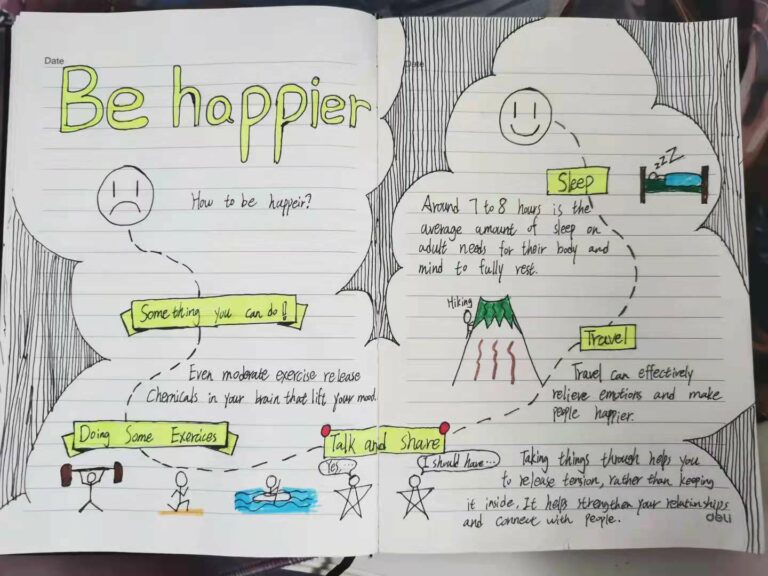In recent years, the number of people with depression has increased year by year. Studying and going to work puts a lot of pressure on many people and leads to people’s unhappiness even made them suffer from depression. People should know how to make them be happier.
Link to the lesson plan: https://docs.google.com/document/d/1t4XU2oQV9pqdD5y7C5PS8UZc2P-glgP4O3L09fmYqsE/edit?usp=sharing
The PowerPoint:
Sketchnoting: Be happier

There are something that can make people be happier:
- Doing Some Exercise: Even moderate exercise releases chemicals in your brain that lift your mood.
- Talk and Share: Taking things through helps you to release tension, rather than keeping it inside. It helps strengthen your relationships and connect with people.
- Travel: Travel can effectively relieve emotions and make people happier.
- Sleep: Around 7 to 8 hours is the average amount of sleep on adult needs for their body and mind to fully rest.
The sketchnoting follow some principles of multimedia learning:
- Multimedia principle: People learn better from words and pictures than from words alone. In this sketchnoting, the combination of images and text can make people learn better.
- Modality principle: People learn better from graphics and narration than from graphics and printed text. Many stick figures man are drawn in the sketchnoting to enhance people’s memory.
- Signalling principle: People learn better when cues are added that highlight the key information and its organization. The sketchnoting used bright yellow in the key information. It makes people know the main points.
- Coherence principle: People learn better when extraneous material is excluded rather than included. The sketchnoting only content related to the topic “Be happier”, and do not have any extra content to distract people.
- Split-attention principle: People learn better when words and pictures are physically and temporally integrated. People can see the images and the key information at the same time.
The video with H5p: Be Happier
The video follow some principles of multimedia learning:
- Multimedia principle: People learn better from words and pictures than from words alone. The video includes images and texts. People will more easily understand what I want to show.
- Split-attention principle: People learn better when words and pictures are physically and temporally integrated. The images and the words will show at the same time in the video. This will deepen people’s impression.
- Modality principle: People learn better from graphics and narration than from graphics and printed text. We recorded the narration of this video.
- Redundancy principle: Unfortunately, when making the PowerPoint, we have tried to reduce the reading burden caused by too much text. However, because there are intext, pictures and narration in the video at the same time, this video has the Redundancy principle.
- Signalling principle: People learn better when cues are added that highlight the key information and its organization. There are some bold words to make people easily focus on the key information during the video.
- Coherence principle: People learn better when extraneous material is excluded rather than included. There are no extra materials in the video. All the content teaches people how to be happier.
- Segmenting principle: People learn better when a multimedia message is presented in learner-paced segments rather than as a continuous unit. The video has recorded a PowerPoint, and the information will show up slide by slide.
- Pre-training Principle: people learn better from a multimedia message when they know the names and characteristics of the main concepts. At the beginning of the video, it introduces emotional contagion. It helps people know that why they need to be happier.
- Personalization principle: People learn better when the words of a multimedia presentation are in conversational style rather than formal style. The video used a conversational style.
- Embodiment Principle: People do not necessarily learn better when the speaker’s image is on the screen. There is no speaker’s image show on the screen. It does not distract people.
- Feedback principle: People learn better from multimedia lessons when they receive explanative feedback on their performance. At the end of the video, people will get result about they answered during the video. This will give them confidence.
- The Voice Principle: The Voice Principle states that humans learn best from a human voice than a computer voice. The video has recorded the own professional narration.
- Dual Coding Theory: The video makes people can learn things by two channels: what he/she see and hear. It will make people learn better.
This is my partner Nathan’s link: https://nathanyi.opened.ca/2021/04/12/how-to-be-happier/
References:
https://www.nhs.uk/mental-health/self-help/tips-and-support/how-to-be-happier/
https://www.healthline.com/health/how-to-be-happy
https://docs.google.com/document/d/1TGVFG_iCc3iSz3aX3j8UC-YC63V__6tKFJQ4FtAsH4o/edit#
https://link.gale.com/apps/doc/A238430439/ITBC?u=uvictoria&sid=ITBC&xid=bebef3f2